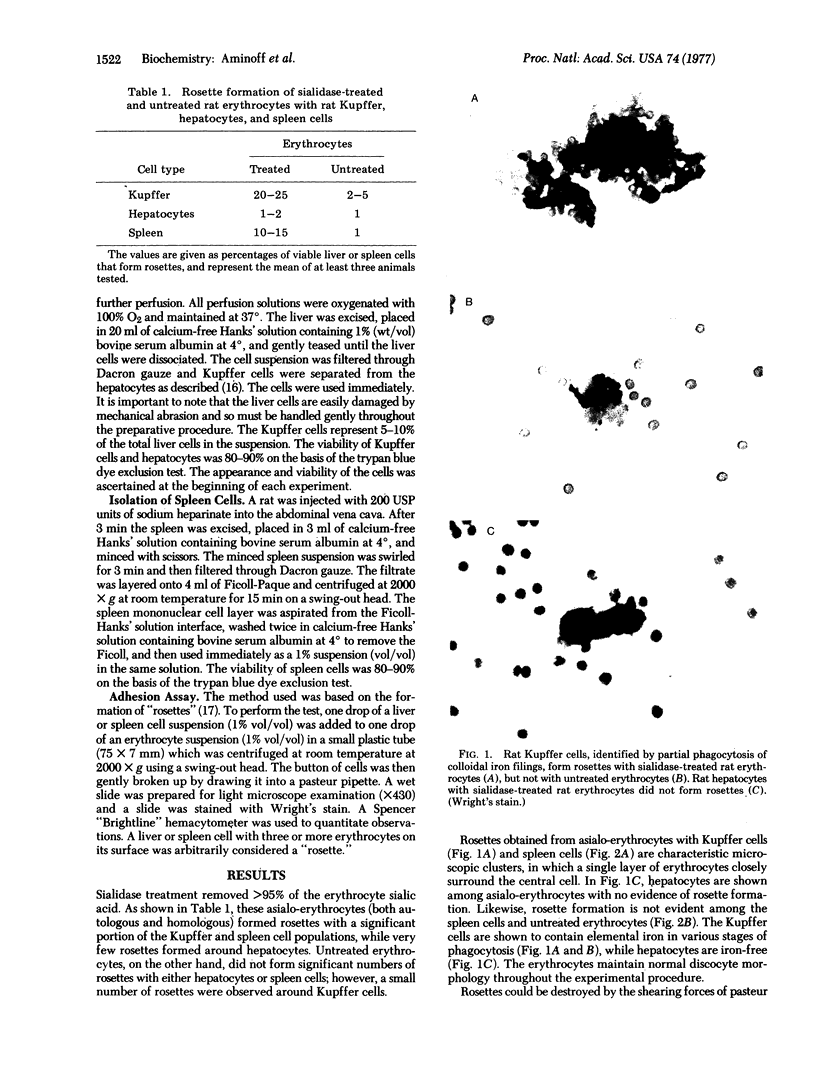Abstract
Sialidase (neuraminidase; acylneuraminyl hydrolase; EC 3.2.1.18)-treated erythrocytes obtained from different species are susceptible to rapid elimination from the circulation and are sequestered in the liver and spleen. The present studies were concerned with the mechanism of this clearance and how it may relate to the normal physiological process of removing senescent erythrocytes from the circulation. The results obtained indicate a preferential recognition of sialidase-treated as compared to normal erythrocytes by mono-nuclear spleen cells and Kupffer cells of the liver. This recognition manifests itself in both autologous and homologous systems by adhesion of the complementary cells in the form of rosettes, and as such could explain the removal of enzyme-treated erythrocytes from the circulation with their accumulation in liver and spleen. This phenomenon may represent a normal physiological mechanism for removal of senescent erythrocytes containing decreased sialic acid.
Full text
PDF



Images in this article
Selected References
These references are in PubMed. This may not be the complete list of references from this article.
- AMINOFF D. Methods for the quantitative estimation of N-acetylneuraminic acid and their application to hydrolysates of sialomucoids. Biochem J. 1961 Nov;81:384–392. doi: 10.1042/bj0810384. [DOI] [PMC free article] [PubMed] [Google Scholar]
- Aminoff D., Bell W. C., Fulton I., Ibgebrigtsen N. Effect of sialidase on the viability of erythrocytes in circulation. Am J Hematol. 1976;1(4):419–432. doi: 10.1002/ajh.2830010407. [DOI] [PubMed] [Google Scholar]
- Ashwell G., Morell A. G. The role of surface carbohydrates in the hepatic recognition and transport of circulating glycoproteins. Adv Enzymol Relat Areas Mol Biol. 1974;41(0):99–128. doi: 10.1002/9780470122860.ch3. [DOI] [PubMed] [Google Scholar]
- Baxter A., Beeley J. G. Changes in surface carbohydrate of human erythrocytes aged in vivo. Biochem Soc Trans. 1975;3(1):134–136. doi: 10.1042/bst0030134. [DOI] [PubMed] [Google Scholar]
- Brain P., Gordon J., Willetts W. A. Rosette formation by peripheral lymphocytes. Clin Exp Immunol. 1970 May;6(5):681–688. [PMC free article] [PubMed] [Google Scholar]
- Durocher J. R., Payne R. C., Conrad M. E. Role of sialic acid in erythrocyte survival. Blood. 1975 Jan;45(1):11–20. [PubMed] [Google Scholar]
- Gattegno L., Bladier D., Cornillot P. Ageing in vivo and neuraminidase treatment of rabbit erythrocytes: influence on half-life as assessed by 51Cr labelling. Hoppe Seylers Z Physiol Chem. 1975 Apr;356(4):391–397. doi: 10.1515/bchm2.1975.356.1.391. [DOI] [PubMed] [Google Scholar]
- Gattegno L., Bladier D., Cornillot P. The role of sialic acid in the determination of survival of rabbit erythrocytes in the circulation. Carbohydr Res. 1974 Jun;34(2):361–369. doi: 10.1016/s0008-6215(00)82911-0. [DOI] [PubMed] [Google Scholar]
- Gregoriadis G., Putman D., Louis L., Neerunjun D. Comparative effect and fate of non-entrapped and liposome-entrapped neuraminidase injected into rats. Biochem J. 1974 May;140(2):323–330. doi: 10.1042/bj1400323. [DOI] [PMC free article] [PubMed] [Google Scholar]
- Jancik J., Schauer R. Sialic acid--a determinant of the life-time of rabbit erythrocytes. Hoppe Seylers Z Physiol Chem. 1974 Apr;355(4):395–400. doi: 10.1515/bchm2.1974.355.1.395. [DOI] [PubMed] [Google Scholar]
- Jancik J., Schauer R., Streicher H. J. Influence of membrane-bound N-acetylneuraminic acid on the survival of erythrocytes in man. Hoppe Seylers Z Physiol Chem. 1975 Aug;356(8):1329–1331. [PubMed] [Google Scholar]
- KLENK E., LAUENSTEIN K. Uber die zuckerhaltigen Lipoide des Erythrocytenstromas von Mensch und Rind. Hoppe Seylers Z Physiol Chem. 1953 Jan 30;291(5-6):249–258. [PubMed] [Google Scholar]
- Morell A. G., Gregoriadis G., Scheinberg I. H., Hickman J., Ashwell G. The role of sialic acid in determining the survival of glycoproteins in the circulation. J Biol Chem. 1971 Mar 10;246(5):1461–1467. [PubMed] [Google Scholar]
- Morell A. G., Irvine R. A., Sternlieb I., Scheinberg I. H., Ashwell G. Physical and chemical studies on ceruloplasmin. V. Metabolic studies on sialic acid-free ceruloplasmin in vivo. J Biol Chem. 1968 Jan 10;243(1):155–159. [PubMed] [Google Scholar]
- Morell A. G., Van den Hamer C. J., Scheinberg I. H., Ashwell G. Physical and chemical studies on ceruloplasmin. IV. Preparation of radioactive, sialic acid-free ceruloplasmin labeled with tritium on terminal D-galactose residues. J Biol Chem. 1966 Aug 25;241(16):3745–3749. [PubMed] [Google Scholar]
- Wincek T. J., Hupka A. L., Sweat F. W. Stimulation of adenylate cyclase from isolated hepatocytes and Kupffer cells. J Biol Chem. 1975 Nov 25;250(22):8863–8873. [PubMed] [Google Scholar]
- Yaari A. Mobility of human red blood cells of different age groups in an electric field. Blood. 1969 Feb;33(2):159–163. [PubMed] [Google Scholar]







